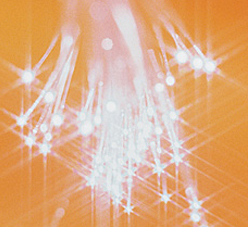
After the cable is stripped, the ST connector must be prepared for use.
Simply apply a dab of a quick-drying epoxy resin on the end of the optical connector.
Once the resin is applied, immediately insert the fiber into a precision hole in the connector pin.
At this point, with the fiber inserted through the connector hole, the fiber tip should be protruding from the front of the connector pin. Apply a small bead of epoxy to this exposed end, and set the fiber/connector assembly aside to dry properly. Ideally, the epoxy should be allowed to dry overnight, but a 1-hour drying time is sufficient when time is not available.
Once the epoxy is completely dry, use a scribing tool, which looks similar to a paring knife, to score the fiber close to the epoxy bead. It is important that the fiber be cut flush with the end of the connector pin.
Next, the fiber tip must be ground down and polished. A sanding plate is used to smooth away any fiber that may be protruding through the epoxy.
After sanding, you should see a very small black dot on the epoxy. This is the actual end of the fiber.
Last, the fiber must be polished. A polishing wheel coated in a finer grit micro-polish is used to remove any small particles that may still be on the tip of the fiber.
After polishing, a compressed air hose is used to blow off any microscopic particles. Then a lint-free wipe with some rubbing alcohol is used to clean the optic tip.
Testing
The termination is now complete, but it is good practice to do some quick testing at this point. Otherwise, problems may arise during or after installation, at which point diagnosis will be more difficult.
The first step is to examine the connector under a fiber-optic scope to make sure it is not exposed, broken, cracked or plucked (i.e., riddled with small holes made by particles as a result of scoring the fiber). Next, the connector should be attached to either a transmission unit or a test fixture that tests the loss in dB of the fiber cable.
Fiber that has been correctly terminated should show no additional loss as a result of the added connector.
